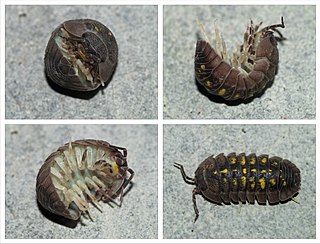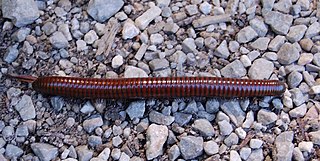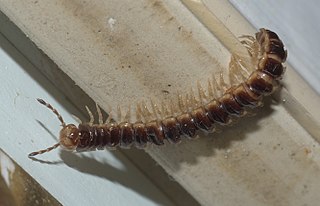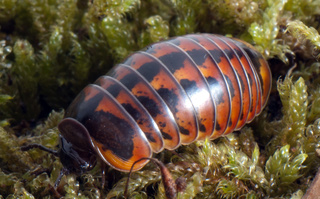
Armadillidiidae is a family of woodlice, a terrestrial crustacean group in the order Isopoda. Unlike members of some other woodlice families, members of this family can roll into a ball, an ability they share with the outwardly similar but unrelated pill millipedes and other animals. This ability gives woodlice in this family their common names of pill bugs or roly polies. Other common names include slaters,potato bugs, butchy boys and doodle bugs. Most species are native to the Mediterranean Basin, while a few species have wider European distributions. The best-known species, Armadillidium vulgare, was introduced to New England in the early 19th century and has become widespread throughout North America.

Pill millipedes are any members of two living orders of millipedes, often grouped together into a single superorder, Oniscomorpha. The name Oniscomorpha refers to the millipedes' resemblance to certain woodlice (Oniscidea), also called pillbugs or "roly-polies". However, millipedes and woodlice are not closely related ; rather, this is a case of convergent evolution.

Glomeris is a genus of pill millipedes that belongs to the family Glomeridae and order Glomerida. The genus Glomeris is the largest within the family Glomeridae, comprising about 100 species along with a few hundred subspecies, varieties, forms, or genetic aberrations. The genus is primarily distributed in Europe, but can also be found in the Canary Islands, North Africa, and North-western Anatolia.

Sphaerotheriida is an order of millipedes in the infraclass Pentazonia, sometimes known as giant pill millipedes. They inhabit Southern Africa, Madagascar, South and Southeast Asia, Australia and New Zealand. Like the Northern Hemisphere pill millipedes of the order Glomerida, these millipedes can roll into a ball when disturbed. When they are rolled-up, most sphaerotheriidans reach a maximum size of a cherry or golf ball, but some species from Madagascar can even reach the size of an orange. When rolled-up, predators are unable to unravel giant pill millipedes since the margins of their second and last dorsal plates fit perfectly into one another, creating a sealed ball. A few giant pill millipede species are able to produce sound, the only millipedes known to do this. This order of millipedes is also unique in that some African species are used for medicinal purposes.

Julida is an order of millipedes. Members are mostly small and cylindrical, typically ranging from 10–120 millimetres (0.39–4.72 in) in length. Eyes may be present or absent, and in mature males of many species, the first pair of legs is modified into hook-like structures. Additionally, both pairs of legs on the 7th body segment of males are modified into gonopods.

Pachyiulus is a genus of julid millipedes containing the following species:

Julus is a genus of millipedes in the family Julidae, containing the following species:

Chordeumatida is a large order of millipedes containing some 1200 species with a nearly worldwide distribution. Also known as sausage millipedes, they grow and develop through a series of moults, adding segments until they reach a fixed number in the adult stage, which is usually the same for a given sex in a given species, at which point the moulting and the addition of segments and legs stop. This mode of development, known as teloanamorphosis, distinguishes this order from most other orders of millipedes, which usually continue to moult as adults, developing through either euanamorphosis or hemianamorphosis.

Glomeris klugii is a species of pill millipede within the genus Glomeris and family Glomeridae. The species is highly variable in colouration, with more than 40 varieties and subspecies identified, each displaying unique colour patterns. The diverse colour patterns of G. klugii can be visually striking, and certain patterns are geographically restricted, leading to the species being associated with numerous taxonomic synonyms.

Glomeris connexa is a species of pill millipede within the genus Glomeris and family Glomeridae.

Geophilus is a large, heterogeneous genus of soil centipedes in the family Geophilidae largely considered to be synonymous with Brachygeophilus. It is a mostly holarctic genus characterized by a claw-shaped ultimate pretarsus, anterior porefields, complete or nearly complete coxo-pleural sutures at the prosternum, and incomplete chitin-lines. Centipedes in this genus range from 1 cm to 8 cm in length. The generic name first appeared in Brewster's Edinburgh Encyclopaedia in 1814 as Geophilus electricus.

Schizopetalidae is a family of crested millipedes in the order Callipodida. There are more than 10 genera in Schizopetalidae.

Oxidus is a genus of flat-backed millipedes in the family Paradoxosomatidae. There are about nine described species in Oxidus.
Chordeumatidae is a family of millipedes belonging to the order Chordeumatida. These millipedes range from 7 mm to 18 mm in length and are found in Europe. Adult millipedes in this family have either 28 or 30 segments. This family features distinctive sex-linked modifications to the legs in adults: In the adult female, a legless sternite replaces the third pair of legs, and in the adult male, five pairs of legs are modified in the gonopod complex. These modifications are more extensive than those found in other adult males in this order, which often have only two leg pairs modified into gonopods. With the more extensive modifications to the legs in this family, species with the usual 30 segments feature adult females with only 49 leg pairs and adult males with only 45 pairs of walking legs, and species with only 28 segments feature adult females with only 45 leg pairs and adult males with only 41 pairs of walking legs.

Glomeris aurita, also known as the golden-eared pill millipede, is a species of pill millipede belonging to the genus Glomeris and the family Glomeridae.

Glomeris oblongoguttata, also known as the painted lady pill millipede, is a species of pill millipede belonging to the genus Glomeris and the family Glomeridae.

Glomeris hexasticha, also known as the Eastern six-striped pill millipede or the diagonal-striped pill millipede, is a species of pill millipede within the family Glomeridae and order Glomerida. The pill millipede is widely distributed within many European countries, with the species consisting of over twenty different subspecies.

Glomeris balcanica, also known as the Balkan pill millipede, is a species of pill millipede within the family Glomeridae and order Glomerida.

Glomeris ornata, is a species of pill millipede within the genus Glomeris and family Glomeridae.

Glomeris guttata is a species of pill millipede within the genus Glomeris and family Glomeridae.



















